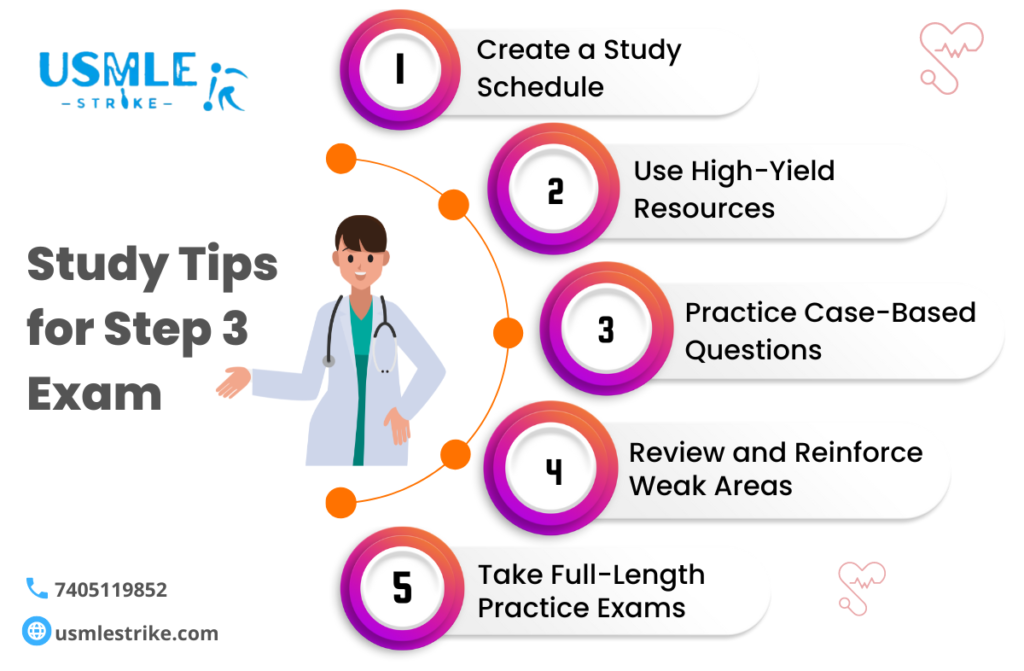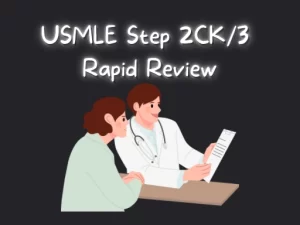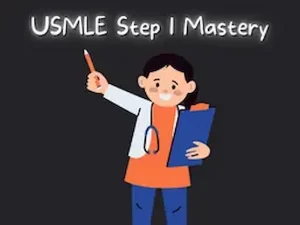USMLE Step 3 Exam is the final step in the United States Medical Licensing Examination (USMLE) sequence. To get eligible for the Step 3 exam, a medical aspirant has to clear the previous USMLE exams (Step 1 and Step 2 CK). Additionally, the USMLE Step 3 exam is divided into two separate days where the 2nd day includes not only MCQs but also case simulations. Every USMLE aspirant has to adopt a tailored approach to studying for this specific exam.
What is the USMLE Step 3 Exam?
The USMLE Step 3 is a licensure exam to assess the competencies of the medical students in the biomedical and clinical sciences essential for practicing medicine unsupervised, emphasizing patient management in ambulatory settings. It is the last of the three USMLE exams which results in a license to practice medicine independently.
USMLE Step 3 Exam presents medical aspirants with clinical situations that they are likely to encounter in various real-life situations to determine their readiness to practice medicine more responsibly and independently.
Eligibility Requirements for Step 3 Exam
The eligibility requirements for Step 3 are as follows
- Completion of Step 1, Step 2 Clinical Knowledge (CK).
- Having graduated from a medical school that is listed in the World Directory of Medical Schools.
- Successful completion of a clinical skills examination or its equivalent, if required by the medical licensing authority where you are applying.

Registration
- How to Register:
- Register through the FSMB website. Ensure all eligibility criteria are met before applying.
- Documents Required:
- Proof of Graduation: Diploma or transcript.
- Previous Exam Scores: USMLE Step 1 and Step 2 CK.
- Confirmation:
- Receive a confirmation email after registration is complete.
- Tip:
- Double-check your personal information and exam location to avoid any errors.
Step 3 Application Fees
| Category | Fee (Approximate) |
|---|---|
| Standard Application Fee | $925 (as of 2025) |
| Prometric Rescheduling Fees | Varies based on how early you reschedule (ranges from $0 to $128) |
| Additional Preparation Resources | Varies (depending on choice of review books, Qbanks, etc.) |
| Travel & Accommodation | Applicable if testing outside your city (costs vary) |
| State Licensure Fees | Separate fee if applying for licensure before Step 3 |
Note: The Step 3 exam fee is paid directly through the FSMB (Federation of State Medical Boards). Prices are subject to change based on policy updates.
USMLE Step 3 Exam Pattern 2025
Day 1: Foundations of Independent Practice (FIP)
This section tests your ability to apply basic medical sciences in clinical contexts. It focuses on foundational knowledge that supports safe and effective patient care.
- Number of Questions: 232 multiple-choice questions (MCQs).
- Format: Questions are divided into six blocks of 38–39 questions each, with 60 minutes allocated per block.
- Content Areas: Covers topics like pathophysiology, pharmacology, epidemiology, biostatistics, and diagnostic reasoning. The focus is on applying foundational knowledge to clinical scenarios.
- Total Time: Approximately seven hours, including optional breaks and a brief tutorial.
Day 2: Advanced Clinical Medicine (ACM)
This day focuses on your clinical judgment, decision-making, and ability to manage complex cases. It simulates real-world patient care through both MCQs and case simulations.
- Number of Questions: 180 multiple-choice questions (MCQs) and 13 computer-based case simulations (CCS).
- Format: MCQs are split into six blocks of 30 questions each, with 45 minutes per block. CCS cases simulate real-time clinical scenarios requiring decision-making over a timeline.
- Content Areas: Emphasizes clinical decision-making, acute and chronic care, patient management, and long-term follow-up strategies.
- Total Time: Approximately nine hours, including breaks and instructions.
USMLE Step 3 Syllabus
- Day 1 – Foundations of Independent Practice (FIP):
- Focuses on basic medical sciences and patient management.
- Systems Covered: Cardiovascular, Gastrointestinal, Respiratory, etc.
- Day 2 – Advanced Clinical Medicine (ACM):
- Emphasizes diagnosis and management, integrating clinical science into patient care.
- Systems Covered: Psychiatry, Emergency Medicine, Neurology, etc.
- Study Tips:
- Focus on the high-yield areas and case-based questions.
- Revise clinical guidelines and protocols for emergency cases.
USMLE Step 3 Score
Your USMLE Step 3 score plays a critical role in determining your readiness for unsupervised practice. The scoring process is as follows:
- The passing score for the USMLE Step 3 exam is 198.
- Scores range from 120 to 300.
- Score reports are typically available 3-4 weeks after your test.
- Step 3 scores are used by residency programs to evaluate your readiness for medical practice.
What Affects Your Score?
- Performance in both foundational medical knowledge and clinical decision-making.
- Day 2 of the exam, which focuses on Advanced Clinical Medicine, is weighted more heavily.
Tips for Scheduling and Preparing for USMLE Step 3
- Plan Ahead: Schedule your USMLE Step 3 exam several months in advance to secure your preferred date.
- Know the Exam Format: Understand the USMLE Step 3 syllabus, focusing on the content for both the multiple-choice and clinical case components.
- Set a Study Plan: Dedicate 3–6 months to studying. Break down topics into manageable sections, using USMLE Step 3 sample questions to guide your review.
- Balance Work and Study: If possible, take time off from clinical rotations to focus entirely on preparation.
- Stay Consistent: Review daily, focusing on weak areas and practicing USMLE Step 3 sample questions to build confidence and improve test-taking skills.
Best Step 3 Study Resources
Preparing for the USMLE Step 3 exam requires access to the best study resources to help you succeed. Here are some of the top study materials recommended by medical professionals:
- USMLEStrike: This innovative platform offers a targeted approach with a robust question bank and performance tracking. It focuses on high-yield topics and provides detailed explanations, helping students strengthen their clinical knowledge and test-taking strategies effectively.
- UWorld for Step 3: A popular question bank that offers over 1,600 practice questions tailored specifically for the USMLE Step 3 exam. It also includes interactive case simulations to enhance clinical skills.
- First Aid for the USMLE Step 3: A comprehensive review book that covers high-yield topics, making it a great complement to practice questions for efficient studying.
- Kaplan Step 3 Qbank: Provides a diverse range of questions with detailed explanations to enhance clinical reasoning and understanding of complex concepts.
- NBME Practice Exams: Simulates the real USMLE Step 3 exam format, allowing candidates to assess their readiness with authentic questions.
These resources provide a solid foundation for tackling the two-day USMLE Step 3 exam, focusing on both medical knowledge and clinical skills. Make sure to use them effectively in your study plan!
Utilizing Resources like USMLEStrike for Preparation
- Comprehensive Content: USMLEStrike offers a collection of high-quality study materials, including the USMLE Step 3 syllabus, practice questions, and mock exams.
- Practice Questions: It provides USMLE Step 3 sample questions that closely resemble the real exam format, helping you become familiar with the style and difficulty.
- Study Plans and Tips: USMLEStrike also offers study schedules tailored to your exam timeline, optimizing your preparation efforts.
- Expert Insights: Access expert explanations for difficult questions, which can help clarify complex topics covered in the Best Step 3 study resources.
Next Steps After Completing the Step 3 Exam
- Wait for Results: After taking the USMLE Step 3 exam, you will typically wait around 3–4 weeks for your results. During this time, ensure your residency applications are progressing.
- Evaluate Your Performance: Review your USMLE Step 3 results carefully, identifying areas for improvement. Consider discussing them with mentors to plan your next steps.
- Residency Application: If you haven’t already, begin submitting your application for residency programs. Step 3 results are often required for full application completion.
- Prepare for Interviews: Prepare for residency interviews by revisiting clinical knowledge from your USMLE Step 3 syllabus. Use your Step 3 experience to highlight your readiness for independent practice.
- Ongoing Learning: Even after completing the exam, continue to refine your medical knowledge. The skills tested in USMLE Step 3 are relevant to your career as a physician, and ongoing learning will benefit your future practice.
USMLE Step 3 Sample Questions
A 27-year-old man presents with progressive balance problems and inability to walk over the past 2 days. He has a history of optic neuritis. On examination, he has spasticity, weakness, hyperactive reflexes, clonus, and sensory deficits in the lower extremities. These findings suggest a lesion in the spinal cord. Which cell type is most affected in this condition?
(A) Astrocytes
(B) Ependymal cells
(C) Neurons
(D) Oligodendrocytes
(E) Schwann cells
(Answer: D)
A 2-year-old girl with sickle cell disease presents with painful swelling of her feet for the past 3 hours. She has a temperature of 37°C (98.6°F), and her lab results show low hemoglobin (7.8 g/dL), mild leukocytosis (13,000/mm³), and a normal differential. What is the most likely diagnosis?
(A) Bone infarction
(B) Escherichia coli sepsis
(C) Osteomyelitis
(D) Pneumococcal sepsis
(E) Staphylococcal sepsis
(Answer: A)
A 24-year-old man and a 22-year-old woman come for premarital counseling. Neither has been sexually active, used illicit drugs, or had blood transfusions. They ask whether they should get an HIV test before marriage. Compared to individuals with multiple risk factors for HIV, which of the following statements best applies to this couple?
(A) The negative predictive value of the test would be lower
(B) The positive predictive value of the test would be lower
(C) The sensitivity of the test would be higher
(D) The sensitivity of the test would be lower
(E) The specificity of the test would be lower
(Answer: B)
A 54-year-old man with no prior health issues visits the emergency department at his wife’s urging, six days after being bitten on his right leg by a stray dog during a trip to South America. The bite punctured the skin, and the patient immediately cleaned the wound thoroughly with soap and peroxide, continuing to do so daily. The wound is not painful, and he has not experienced fever or chills. He does not take any medications and received a tetanus booster 3 years ago. On examination, his vital signs are normal, and the bite wound is healing with minimal erythema, no fluctuation, and no palpable lymph nodes in the groin. What is the most appropriate next step in management?
(A) Administer rabies vaccination
(B) Administer tetanus immune globulin
(C) Order cerebrospinal fluid analysis
(D) Order an MRI of the brain and spine
(E) No action is necessary at this time
(Answer: A)
Conclusion
While supplementary textbooks and practice questions remain the backbone to tackle the MCQ’s, handle the CCS cases and the logistics, joining the Best USMLE coaching centre in India like the USMLE Strike would definitely be a boon to level up your confidence, dedication and time to get a standard coaching at reasonable USMLE Step 3 cost besides achieving the best results.
Read Also: USMLE Step 2 CK/3 Course





